How to fast-track learning in the workplace

Training sessions, professional development, change management and performance support usually pursue the same goal – giving employee performance a lasting boost. Yet when companies rely exclusively on formal training methods for this purpose, the outcome tends to be less than satisfactory. The situation is quite different with a holistic learning approach. When formal and informal methods of learning strategically build upon each other, there is much quicker progression along the learning curve – much to the satisfaction of the workforce and the company.
The five moments of need
If you look at the situations in which staff require experience-based expertise, information or practical support, it quickly becomes clear that a single method of knowledge transfer is nowhere near enough. Bob Mosher and Dr. Conrad Gottfredson have developed a model that structures learner requirements based on the situation they are in. In total, they distinguish between five moments of need:
- We are learning something for the first time (New)
Example: Learning the basics of a new software program - We want to expand or deepen our knowledge (More)
Example: Understanding detailed processes or background information - We want to apply or remember something we have learned (Apply)
Example: Using the new software program in day-to-day operations - We want to solve a problem and do not know what to do (Solve)
Example: The system is not working as expected - A familiar situation has changed (Change)
Example: Finding your way in the application after a new release
A thought-through learning plan
For the first two moments of need, which primarily focus on the acquisition of knowledge, formal training methods are a good option. However, if employees want to apply what they have learned in their work, classroom training sessions or online courses are of little use. Conventional training formats are also rarely beneficial when employees have to deal with an unexpected turn of events. If they want to put newly acquired knowledge into practice, tackle a problem or tweak something (Apply, Solve, Change), they therefore need support directly at their workplace – in the form of performance support, for instance.
Ebbinghaus’ forgetting curve
Don't get stuck in the 80's!
However, there is another reason why companies should combine formal and informal training offerings – people forget. The German psychologist Professor Hermann Ebbinghaus was one of the first in his field to take a close look at the learning process and how we forget. His book “Memory: A Contribution to Experimental Psychology”, which he published back in 1885, is regarded as pioneering in the field. The forgetting curve developed therein outlines how long humans can retain newly acquired knowledge and what percentage they forget over time.
Ebbinghaus discovered that humans can only recall 60 percent of new information just 20 minutes after learning it. After an hour, this figure drops to 45 percent, decreasing further to around 33 percent after a day. In the medium term, a mere 15 percent of what we learn stays anchored in our brains. In other words, we forget a great deal.

Ebbinghaus’ forgetting curve
Enhancing the learning curve
There is a bright side to all this, however, as the progression of a learning curve – which is defined as the rate at which a learner gains new skills – depends on a whole host of things. Regularly revising or constantly applying what you have learned can improve the learning outcome considerably. Teaching and learning techniques, educational resources and social factors also have a huge impact on whether new knowledge takes root in the brain. A good mix of formal and informal learning methods and the right timing therefore form the basis of a steep learning curve.
Learning in day-to-day working life
Nonetheless, a great many companies today still pin their hopes on formal training concepts such as classroom training sessions and online courses. These methods convey extensive knowledge about processes and functions, causing employees’ learning curves to jump upward. But if, say, a new software program is not rolled out until weeks after the relevant training session, employees have naturally long forgotten what they learned. After all, who has time for regular revision? Despite their training, the employees consequently struggle to work with the new tool without the assistance of others. Forced to bother experienced colleagues or turn to the help desk, they become increasingly frustrated.
Replacing revision with performance support
The concept of performance support, which is classed as an informal method of learning, was developed to lend a hand in these kinds of situations and ensure employees can enjoy a positive experience curve. If staff wish to put newly acquired knowledge into practice, tackle a problem or tweak something (Apply, Solve, Change), they are given the exact information or instructions they require in that specific “moment of need” – be it within a software application or while performing tasks not based on IT, such as repair work. In this way, performance support closes the gap between a limited ability to memorize information and the need for constant revision, thereby promoting an upward learning curve.
Example – roll-out of new software
The most effective way to tackle the issue of forgetting in company training is therefore to adopt a holistic approach that combines formal and informal learning methods. If you were to apply the Ebbinghaus forgetting curve to an IT project, the situation would unfold as follows:

Forgetting curve using the example of the rollout of a new software
If employees are given training weeks before the go-live and no further action is taken to commit the taught content to memory, they will struggle to remember the individual process steps by the time the software is rolled out. The time and effort invested in the formal training will be pretty much wasted. Only after the go-live do the employees begin to slowly improve their skills. This is because as they go about their day-to-day work – by way of trial and error and by gaining practical experience – they will gradually acquire the necessary know-how and the processes will take root in their memory. This is classic on-the-job learning.
With an approach that combines training sessions and performance support, staff can first focus their learning on conceptional issues and basic processes before the go-live. They devote far less attention to specific actions (for example, how to perform a certain transaction). Although it causes the learning curve to flatten considerably at the start, this way of doing things offers major advantages:
- Since training sessions have been stripped down to the absolute essentials, they take less time and can be moved closer to the go-live date. The forgetting curve can be further flattened by pairing formal training with self-study offerings, motivating video clips and additional information. By postponing the learning process to a later point in time, staff are better equipped for the go-live than they would be with a conventional approach – despite the less intensive preparation.
- Moreover, the staff learning curve makes much greater, much faster progress following the go-live. This is because staff have gained a fundamental understanding of the new software in their preparatory training sessions and are now receiving performance support tailored to their specific work. Performance support offers the users assistance as soon as they need it, helping them get the job done quickly. In next to no time, staff catch up on the skills they usually would have covered before the go-live.
Finally, if you compare the post-go-live staff learning curve for conventional on-the-job learning with the curve for the integrated performance support approach, it becomes clear just how important it is to opt for a strategic mix of learning techniques. Even over a longer period of time, it is impossible to achieve high performance using conventional methods alone.
The right tool for a strategic mix
A holistic approach combining formal training and performance support requires the appropriate technology. An efficient performance support solution helps companies early on as they create their e-learning materials and, if required, also provides the content in formats such as step-by-step guides that can be used later on for performance support purposes. What’s more, a good software solution offers the opportunity to incorporate additional information such as process overviews and industry-specific regulations. Ideally, the solution should cover all five moments of need to ensure staff only have to get to grips with one technology. That way, companies will be perfectly primed to minimize the effects of the Ebbinghaus forgetting curve and cause both the experience curve and the performance of their workforce to skyrocket.




